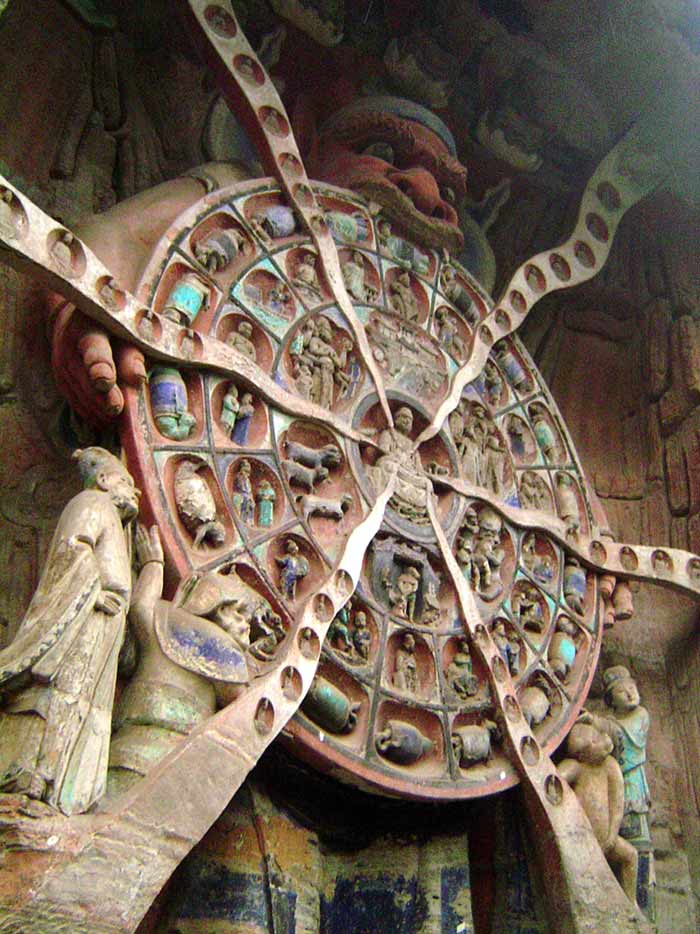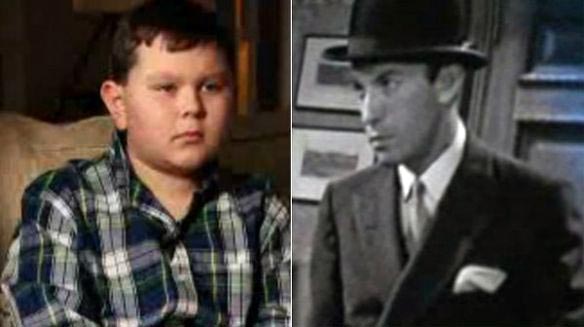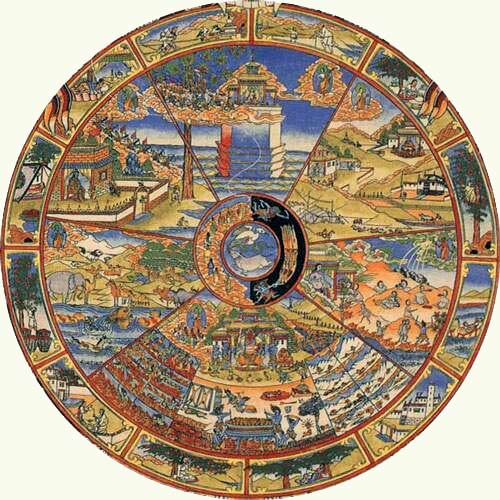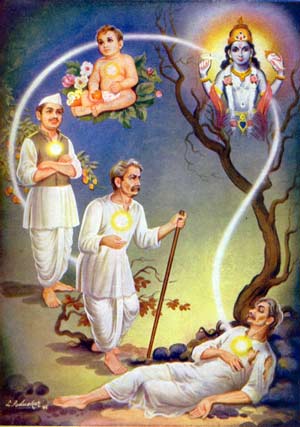In a now famous conversation between Carl Sagan and the Dalai Lama, Sagan, a scientist and renowned skeptic, asks, “Your Holiness, what if we were to
prove, scientifically, that there is no such thing as reincarnation?” To Sagan’s great astonishment, the Dalai Lama replied without hesitation that if
rebirth were to be disproven, then the word would need to be put forth that Buddhists should stop believing in it. The Dalai Lama, however, then stumped
Sagan with the question, “How would one disprove reincarnation?”
How, indeed? Belief in reincarnation, or rebirth, like many other spiritual beliefs, would, at least at first glance, appear incapable of falsification–and
falsifiability is the criterion by which any claim can be said to be properly scientific. In other words, if one wants to assert a scientific claim, one
must be able to answer the question, “What would be needed to disprove this claim?” By what test could one measure the departure of consciousness at the
moment of death, and the continuity of the same stream of awareness in another, newly born or conceived individual? More to the point, how could one
demonstrate in a conclusive fashion that such a transfer never occurs, or that it is impossible?
Some would argue that its very un-testability is a sufficient basis for rejecting the idea of rebirth: that one cannot measure or analyze a soul or stream
of consciousness as it leaves the physical body because there is no such thing as consciousness independent of the life of the brain.

Dazu Wheel of Reincarnation
Dazu Wheel of Reincarnation
This, however, is not a scientific conclusion, but a philosophical assumption. And while it is certainly not an unreasonable assumption to make, it might
also be the case that the death of the brain is analogous to the malfunctioning of a television set or radio. The fact that my TV or radio is broken does
not mean television and radio stations have ceased to broadcast. What if the brain does not generate consciousness, but rather mediates it to the physical
plane of reality to which science has access–the sensory, material world–from a plane no less real, but not amenable to scientific investigation, at least
as science is currently configured? This, of course, is a completely un-falsifiable claim, and many would argue that it is a fanciful one: a product of
wishful thinking, rather than of a clear-headed examination of the available evidence. Fair enough. But, as David Ray Griffin argues, it is not only
believers in the survival of consciousness beyond death who engage in wishful thinking. “The pervasiveness of wishful thinking becomes all the more evident
when we realize that it can be negative as well as positive, as our thoughts about philosophical possibility, and our interpretations of empirical data,
are sometimes guided by what we hope not to be true.” Hermann von Helmholtz, a nineteenth century scientist, provided an example of such negative
wishful thinking when reportedly said of telepathy, “I cannot believe it…[Not] even the evidence of my own senses would lead me to believe in the
transmission of thought from one person to another…It is clearly impossible.”
Such stubborn skepticism, an a priori rejection of the possibility of a phenomenon even before either positive or negative evidence is proffered, would
seem to be as alien to the spirit of empirical research as a stubborn insistence that the phenomenon is real. It is not that either form of insistence is
necessarily wrong; but neither equates to science. Both, rather, are philosophical inclinations, to which one may be drawn for reasons having little or
nothing to do with empirical evidence. A peculiarity of the discussion of the survival of consciousness after death is that one such set of assumptions–the
negative set–is taken by many to be established science, when the reality is that a variety of possible accounts of reality are logically compatible with
our current scientific knowledge.
The pervasive importance of belief in the survival of the conscious entity beyond the death of the body in humanity’s religious and philosophical
traditions, including among believers who are also scientists, suggests that this is an idea that one can take seriously without running afoul of our best
current science on the mechanics of consciousness: the workings of the brain, which parts of the brain are active when we experience particular mental and
emotional states, and so on.
Science, in other words, is compatible with a variety of ontologies: a wide range of views about the ultimate nature of reality, beyond what science itself
is able to confirm or to reject. Science tends to be widely associated with a materialist ontology: the view that the world visible to the senses (or their
extensions, via instrumentation) is all that exists. It is logically possible, though, to affirm the findings of science while holding a variety of other
views about those areas that are not amenable to scientific investigation.
Given the inapplicability of the scientific method to the question of rebirth, belief in this phenomenon typically belongs to the realm of religion and
philosophy. It is something that people affirm not due to a rigorous examination of scientifically tested evidence, but because it plays an important role
in their worldview or system of values. For many, the idea of rebirth, along with the closely connected concept of karma, a principle of cosmic justice,
together provide a psychologically reassuring and logically consistent answer to existential questions like, “What happens to our consciousness after
physical death?” and “Why does there seem to be so much undeserved suffering in the world?”
At the same time, though, a strong denial of the reality of rebirth is similarly rooted in a set of philosophical principles, and not in the conclusions of
science–because, again, this is not a scientific question. Although many will affirm that neuroscience has proven that consciousness is an effect of brain
activity, and that there is no such thing as an afterlife in the traditional religious sense, this is not a scientific conclusion, but rather a logical
leap from science to metaphysics. The scientific data in this field, while giving us a great deal of useful and important information about the function of
the brain, underdetermines the question of the nature and origin of consciousness. The widespread affirmation by a good many neuroscientists, therefore,
that neuroscience has proven the non-existence of a consciousness that survives physical death, is an error that is based on “negative wishful thinking.”
Neuroscience has proven no such thing. It has shown that a great deal about the structure of our consciousness at a given moment can be explained by brain
activity. But it cannot prove the falsehood of an un-falsifiable claim.
Again, the argument here is not that the reductionist materialism of many neuroscientists is indefensible. But it is rarely ever given a proper
philosophical defense. Rather, it is simply assumed. When one takes into account that another possible approach to the nature of consciousness is available
from within the realm of science itself–at the cutting edge of physics–such reductionist assumptions appear even less justifiable. Marilynne Robinson puts
the matter incisively, “Nothing can account for the reductionist tendencies among neuroscientists except a lack of rigor and consistency, a loyalty to
conclusions that are prior to evidence and argument, and an indifference to science as a whole.”
 From the pragmatist perspective of the philosopher William James–who, though skeptical of such things, was, unlike Hermann von Helmhotz, at least open to
testing paranormal phenomena–the question of rebirth, like the question of the existence of a deity or deities, is in the realm of topics on which no
conclusive evidence, positive or negative, can be presented. According to James, one is free to believe in such things or not, depending on how such belief
or disbelief fits into the larger worldview through which one finds meaning in life. Those who are inclined to believe in rebirth because it helps them
make sense of their life experiences in a profound way are free to do so, and those who are inclined to reject this notion as a superstition are equally
free to do so on the basis of its un-testability. Both may claim that their views are consistent with science, which, at least as currently configured, is
not in a position either to confirm or to deny conclusively whether rebirth occurs.
From the pragmatist perspective of the philosopher William James–who, though skeptical of such things, was, unlike Hermann von Helmhotz, at least open to
testing paranormal phenomena–the question of rebirth, like the question of the existence of a deity or deities, is in the realm of topics on which no
conclusive evidence, positive or negative, can be presented. According to James, one is free to believe in such things or not, depending on how such belief
or disbelief fits into the larger worldview through which one finds meaning in life. Those who are inclined to believe in rebirth because it helps them
make sense of their life experiences in a profound way are free to do so, and those who are inclined to reject this notion as a superstition are equally
free to do so on the basis of its un-testability. Both may claim that their views are consistent with science, which, at least as currently configured, is
not in a position either to confirm or to deny conclusively whether rebirth occurs.
The best candidate, it seems, for scientifically testable evidence for rebirth, is in accounts of past life memory, the details of which can, at least in
principle, be confirmed or proven false. Few scientists, however, pursue research into this phenomenon because it is viewed –due to the pervasiveness of
materialism, as well as Abrahamic religious beliefs, in the scientific community–as well outside the mainstream of acceptable science. As noted by Jonathan
Edelmann and William Bernet, “One reason that parapsychological studies on reincarnation in particular may often be considered outside the pale of solid
academic research is that reincarnation entails an ontology that deeply contradicts contemporary scientific, philosophical, and Christian theological views
of mind consciousness.” There is dogmatism, in other words, in the scientific community just as there is in the realm of religion. So many scientists are
already convinced that reincarnation is impossible that it is not viewed as a worthwhile use of time and resources to pursue research suggesting that it
might, in fact, occur.
The implications, though, were proof of rebirth to emerge, would be profound indeed. As Edelmann and Bernet point out, “If it were shown that a human mind
or consciousness could reincarnate into another body after death, this would have a revolutionary impact on how we understand mind-body relationships, the
nature of human memory, and the ontology of consciousness, as would the studies done on near-death experiences. Moreover, reincarnation would rule out
reductive materialism, and give some credibility to non-physical views of consciousness in Eastern religions such as Hinduism, Buddhism, and Jainism.”
The alleged instances of past life memory that have been investigated by the intrepid scientists who have been willing to pursue this line of research fall
into two categories: spontaneous and hypnotic.
The phenomenon of apparent past life memories emerging during hypnosis is presented famously in the work of Brian L. Weiss, a Miami-based psychiatrist who
documented the memories that emerged in one of his patients after he had placed her under hypnosis in a bestselling book published in 1988 and titled Many Lives, Many Masters. Particularly after the publication of this book, “past life regression” became an increasingly popular element in the
repertoire of New Age spiritualists.
Interesting though the revelations were that occurred when persons were regressed to past lives through hypnosis–a process that many also found to have
therapeutic value–as far as scientific verification of reincarnation went, they proved to be of little value. As a tool of empirical
investigation–including investigation of crimes allegedly occurring during the childhood of regressed patients–hypnosis proved to be unreliable. The power
of leading questions to generate entirely fanciful visions in the minds of patients make it incapable of withstanding rigorous scrutiny. Even in cases
where information given in regression could be independently verified, the possibility could never be entirely discounted that the information in question
was already known, at least on an unconscious level, by either the patient or hypnotist.
Far more promising is the phenomenon of spontaneous past life memory, especially in children. An impressively large number of cases of this kind–cases
numbering in the hundreds–was compiled by University of Virginia professor of psychiatry, Ian Stevenson.
The phenomenon of very young children, between the ages of three and six, claiming to remember details of their past lives is not unheard of in India. A
skeptic, however, might claim that such alleged memories, particularly occurring in a culture where reincarnation is a widely accepted belief, are simply a
reflection of this prevailing belief. Such stories certainly do not meet the rigorous standards of rational inquiry that would be needed for them to be
accepted as scientific proof of rebirth. Children are highly impressionable. A story that might simply begin in the imaginative mind of a child could sound
to an adult who believes in reincarnation like an event from the life of a person they know who has died. Leading questions and prompting might lead the
child, who wants to please adults, to craft a story that fits the details for which the adult is looking, and so thus reaffirms the adult’s belief in
rebirth. This is not science, but wish fulfillment.
Stevenson’s work was plagued by problems of this kind, given that a large number of his cases were drawn from regions such as India and Southeast Asia,
where belief in rebirth is woven into the cultural fabric. It was also argued that Stevenson’s methodology failed to include cases that were not supportive
of his theories–falsifiability, again, being a key component of scientific investigation. Stevenson’s findings were nevertheless extremely interesting,
including numerous cases in which birth defects could be traced to events that allegedly happened in previous lives–such as large moles in places where
candidates said that they had been shot or stabbed in a past incarnation.
It is much more difficult, though, to discount this phenomenon when it occurs in a culture in which belief in reincarnation is widely rejected, such as
that of the United States. Take the case of Ryan, a boy from Oklahoma. Ryan’s parents are conservative evangelical Christians. Belief in reincarnation is
strongly rejected in this religious tradition as a false doctrine, and the broader American culture in which the family lives is strongly skeptical of the
concept (though not all Americans reject the idea of reincarnation, with roughly twenty percent of the population accepting this idea, according to most
opinion polls).

Ryan and Matry Martyn
Around the age of four, “Ryan began talking about going home to Hollywood. He would cry and plead for Cyndi [his mother] to take him home so he could see
his other family.” This account is given in Return to Life, a book by Jim Tucker, the child psychiatrist at the University of Virginia to whom
Ryan’s parents took him for help. Tucker, building on the work and sharpening the methodology of his mentor, Stevenson, has continued to compile cases of
apparent past life memory. Collecting Ryan’s detailed accounts of his past life, and correlating them with carefully researched information, Ryan’s parents
and Tucker concluded that the life Ryan was describing was that of Marty Martyn, an agent from the golden age of Hollywood, but not a person of any
particular fame, and with no connection to Ryan or his family. The details Ryan articulated were not readily available, such as on the internet, and no one
in Ryan’s family, nor Tucker, had any knowledge of Martyn prior to engaging in this research. In the most striking portion of the entire story, Ryan at one
point said, with some frustration, that he did not understand why God would allow someone to live for sixty-one years and then make them come back as a
baby. All of Ryan’s information about Martyn’s life at this point had proven accurate, but on this one point of fact, he was at odds with Martyn’s official
death certificate, which stated that Martyn had died at the age of fifty-nine. Further research, however, proved that Martyn had in fact died at the age of
sixty-one, and that the birth certificate was incorrect. Ryan therefore not only had detailed information about the life of a man no one in his family had
ever met and about whom they had no prior knowledge, but his information actually led to a correction of the public record of the death of that same man.
Is Ryan’s story scientific proof of rebirth? Not necessarily. The phenomenon described here is susceptible to a variety of interpretations, including a
form of telepathic contact between the deceased Marty Martyn and the living Ryan. It does, however, raise serious questions about the standard materialist
paradigm that is used to explain phenomena such as consciousness.
Again, neuroscience tells us a great deal about the mechanics of consciousness: how the interactions of chemicals in various parts of the brain correlate
with specific experiences. One may certainly assume a materialist ontology and take an account of brain activity to be a comprehensive account of
consciousness. But one may also accept the conclusions of neuroscience on the mechanics of consciousness without buying into a materialist view of its
ultimate nature. The fact that my sensory perceptions correlate with activity in part of my brain, and that this activity can be witnessed and measured
scientifically, does not mean that my perceptions are not real: that there is not actually a world I am perceiving. And the fact that my consciousness, to
all appearances, is dependent upon my brain does not mean that my brain might not simply be a tool or vehicle for something beyond itself that is not
reducible to it. As mentioned above, the fact that my television or radio stops working does not mean the television station or radio station has ceased
broadcasting. The science, again, underdetermines the philosophical question of the ultimate nature of things. One who is wedded to a materialist ontology
might be inclined simply to reject the results of Tucker’s research. But this would not be a scientific attitude.

In taking the implications of his research seriously, Tucker has raised the question, “What scientific model of reality might explain phenomena of this
kind better than materialism is able to do?” In response to this question, Tucker, in the final two chapters of Return to Life, explores some of
the implications of recent physics, particularly quantum theory. In these chapters, Tucker makes a number of significant points, including the fact that
there are interpretations of quantum theory according to which consciousness is not merely a by-product or epiphenomenon of material processes, but that it
is foundational to being itself, that our experience of the material world has the character of a collective dream, and, of course, that consciousness can
survive the death of the physical body to be reborn in another form.
In Tucker’s work, importantly, he does not display an extensive or in-depth knowledge of Indian philosophical traditions such as Vedanta, Jainism, or
Buddhism. This is important because he cannot be accused of having a communal axe to grind in advancing his theory, one implication of which is that these
traditions have been right about many things in the basic account of reality that they give. Like Vedanta and Buddhism, Tucker’s theory puts forth the idea
that consciousness is fundamental to the nature of being. Certain aspects of quantum theory also fit well with Jain philosophy. The fact that the same
entity can be validly described as both a wave and a particle, for example, is consistent with the Jain teaching of anekantavada, the
multi-faceted nature of reality, nayavada, the teaching that reality can be viewed from many perspectives, and syadvada, the teaching
that truth can be expressed in a variety of seemingly contradictory ways. And like all three traditions, of course, it affirms the phenomenon of rebirth
itself–including rebirth across species. Interestingly, Tucker’s cases even include one in which a child seems to remember a past life as a snake. This
affirms not only the view of these traditions of consciousness as distinct from the physical body, but also their view that consciousness is not limited to
human beings.
 What should one make of such developments? Tucker’s work is of course exciting news to those of us who are drawn to ideas of this kind, and who practice
one (or more) of the traditions in question. At the same time, the very fact that one would like very much to believe in rebirth is reason for caution.
Just as a materialist errs in simply dismissing the evidence Tucker presents because it does not fit the materialist’s preferred, preconceived metaphysical
paradigm, an adherent of rebirth, and of an idealist metaphysical account of consciousness, would err in exaggerating the scientific conclusiveness of the
information that Tucker has collected–information that is not derived from a repeatable methodology, and which, again, is susceptible to a variety of
possible interpretations. And to the extent that rebirth plays a role in a religious or dharmic worldview, one should be wary about placing too much
reliance on the latest science (which is subject to eventual change given further experimentation and speculation) in cultivating one’s worldview and way
of life. Science cannot be simply set aside, given its explanatory power. But it has proper limits. Ethical and metaphysical reflection must certainly be
informed by science. They cannot, however, be dictated by it. Science is important for playing the role of falsification, for ruling out what cannot be the
case. But there are other foundations for knowledge, other pramāṇas, as well. For those of us who adhere to a Hindu, Buddhist, or Jain worldview, our
belief in rebirth is founded on the yogic perceptions of our ancient seers, as well as, in some cases, our own sādhana, or spiritual practice.
Such practices can provide a self-certifying experiential foundation for a worldview that includes rebirth, and it arguably forms a sufficient basis for an
individual person to hold this belief. It is not, however, the same as science, which involves publicly available, testable, and repeatable knowledge. In
other words, I am certainly justified in believing in rebirth if I am able to remember my own past lives through yogic practice (particularly if the
knowledge I receive thereby is verifiable through other sources, and is consistent with other established knowledge). But this is not a sufficient basis
for another person to hold the same belief, if that person has not had the same experience. This is a subtle, but important difference between the
experiential and empirical approaches to knowledge, the former being the province of spiritual inquiry, the latter of science. These two need not be
incompatible. In fact, they must ultimately be in harmony. But they are not identical.
What should one make of such developments? Tucker’s work is of course exciting news to those of us who are drawn to ideas of this kind, and who practice
one (or more) of the traditions in question. At the same time, the very fact that one would like very much to believe in rebirth is reason for caution.
Just as a materialist errs in simply dismissing the evidence Tucker presents because it does not fit the materialist’s preferred, preconceived metaphysical
paradigm, an adherent of rebirth, and of an idealist metaphysical account of consciousness, would err in exaggerating the scientific conclusiveness of the
information that Tucker has collected–information that is not derived from a repeatable methodology, and which, again, is susceptible to a variety of
possible interpretations. And to the extent that rebirth plays a role in a religious or dharmic worldview, one should be wary about placing too much
reliance on the latest science (which is subject to eventual change given further experimentation and speculation) in cultivating one’s worldview and way
of life. Science cannot be simply set aside, given its explanatory power. But it has proper limits. Ethical and metaphysical reflection must certainly be
informed by science. They cannot, however, be dictated by it. Science is important for playing the role of falsification, for ruling out what cannot be the
case. But there are other foundations for knowledge, other pramāṇas, as well. For those of us who adhere to a Hindu, Buddhist, or Jain worldview, our
belief in rebirth is founded on the yogic perceptions of our ancient seers, as well as, in some cases, our own sādhana, or spiritual practice.
Such practices can provide a self-certifying experiential foundation for a worldview that includes rebirth, and it arguably forms a sufficient basis for an
individual person to hold this belief. It is not, however, the same as science, which involves publicly available, testable, and repeatable knowledge. In
other words, I am certainly justified in believing in rebirth if I am able to remember my own past lives through yogic practice (particularly if the
knowledge I receive thereby is verifiable through other sources, and is consistent with other established knowledge). But this is not a sufficient basis
for another person to hold the same belief, if that person has not had the same experience. This is a subtle, but important difference between the
experiential and empirical approaches to knowledge, the former being the province of spiritual inquiry, the latter of science. These two need not be
incompatible. In fact, they must ultimately be in harmony. But they are not identical.
Because of its many profound implications for spirituality and our understanding of who we are, research of the kind pursued by Jim Tucker clearly deserves
greater attention than it has heretofore received. That is this essay’s plea.